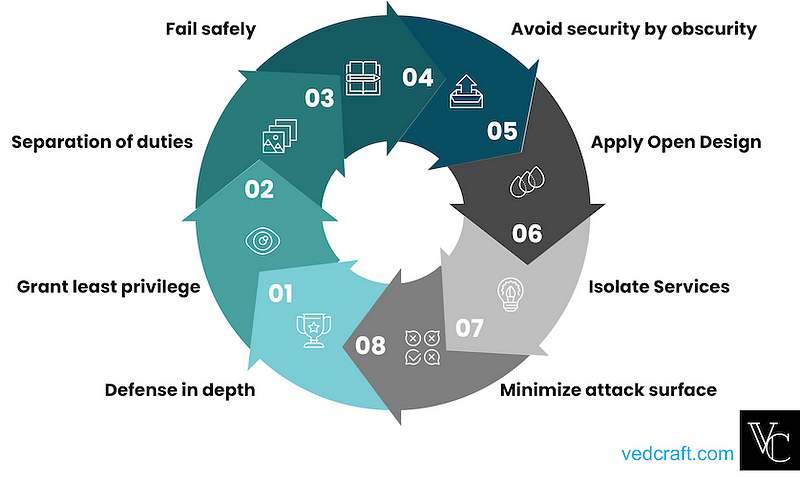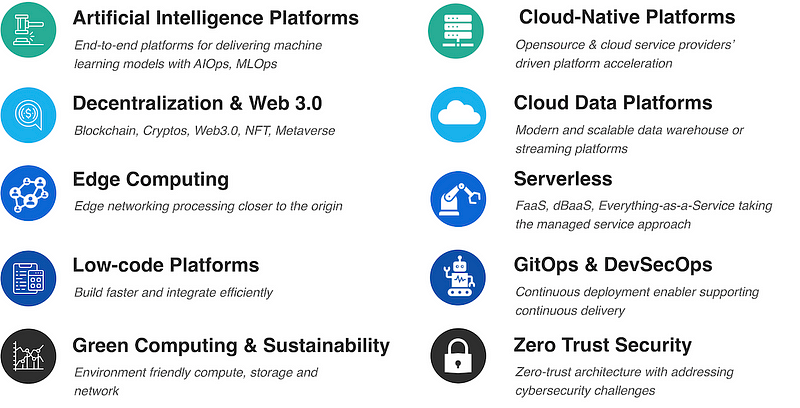Emerging Technology Trends to Watch in 2024 and Beyond
Written on
Chapter 1: Overview of Technology Trends
Monitoring technology trends through the insights of analysts, research firms, and industry leaders offers a comprehensive understanding of the evolving landscape. This knowledge equips software architects to grasp the implications of emerging technologies, allowing them to cultivate essential skills for themselves or their teams. This article outlines the top ten technology trends anticipated for 2024 and the future, drawing upon extensive research.
Section 1.1: Artificial Intelligence Platforms
Artificial Intelligence (AI) and Machine Learning (ML) have become integral to the tech landscape, with the next phase focusing on streamlining associated operations. The implementation of AI engineering practices, such as AIOps, MLOps, and DataOps, will enhance the DevOps culture specifically within AI. Organizations will either develop custom AI platforms utilizing cloud-native services or leverage existing platforms like Dataiku, Amazon SageMaker, Azure AI, Google Vertex AI, DataRobot, IBM Watson, and H2O.ai. The accessibility of AI will expand, involving not just data scientists but also application architects, solution architects, developers, business architects, and product managers.
According to Forrester, the AI software market is projected to reach $37 billion globally by 2025.
Section 1.2: Cloud-Native Platforms
While initial cloud migrations have focused on lift-and-shift strategies, the long-term goal is to embrace cloud-native services that offer scalability, availability, and cost efficiency. Companies will either create their own cloud-native platforms or tailor existing solutions to expedite their digital transformation. Open-source cloud-native technologies are revolutionizing the innovation landscape, with communities like the Cloud Native Computing Foundation (CNCF) promoting open-source and vendor-neutral technologies.
Gartner forecasts that by 2025, cloud-native platforms will support 95% of new digital initiatives, a significant increase from 40% in 2021.
Section 1.3: Decentralization & Web 3.0
With distributed computing at the core of cloud technology, decentralization will continue to advance, driven by innovations within the blockchain ecosystem. Although Web 3.0 has garnered considerable attention, 2022 will mark a period of experimentation, paving the way for future production systems. Key features include:
- The growing popularity of decentralized applications, particularly in the realm of cryptocurrencies.
- Development of solutions such as smart cities utilizing blockchain technology, with a focus on sustainable practices.
- Non-fungible tokens (NFTs) have surged, generating a market value of $23 billion in 2021, up sevenfold from 2020.
- The metaverse, championed by tech giants like Facebook Meta and Microsoft, will expand, integrating technologies like virtual and augmented reality. This virtual universe will utilize decentralization and Web 3.0 technologies, including blockchain.
Initiatives such as Twitter's Bluesky aim to create a decentralized social web, further exemplifying this trend.
The first video discusses the top ten tech trends of 2022, highlighting the critical developments that everyone should be prepared for in the current landscape.
Section 1.4: Serverless Computing
Serverless computing and storage are gaining traction, with 2022 expected to see continued growth in cloud adoption. This model includes offerings such as Function-as-a-Service, Backend-as-a-Service, and more. Major cloud providers like AWS, Azure, and Google Cloud are driving this trend, along with newer players simplifying serverless adoption. Examples of recent innovations include:
- Akka Serverless, launched in June 2021, for real-time applications.
- MongoDB Realm, also launched in June 2021, for building applications powered by MongoDB.
Open-source solutions are also on the rise, enabling users to avoid vendor lock-in. Gartner predicts global cloud spending will soar to $480 billion by 2022.
Section 1.5: Zero Trust Security
With rising cybersecurity threats, Zero Trust security has become a primary focus for organizations adopting cloud technologies. This paradigm shift fosters a new wave of innovative solutions as startups collaborate with cloud vendors. By 2022, it's expected that 80% of new digital applications will adopt a Zero Trust Network Access (ZTNA) model.
By 2023, 60% of enterprises will phase out traditional VPNs in favor of Zero Trust Architecture (ZTA).

Section 1.6: GitOps & DevSecOps
As DevOps matures, its practices will further expand in 2022 to encompass security, machine learning, AI, and continuous delivery. GitOps, which has gained traction since its inception in 2017, will be a focal point for many organizations. Open-source tools like Argo CD and JenkinsX will continue to gain popularity, while established platforms like GitHub will introduce similar capabilities.
DevSecOps promotes early detection of security vulnerabilities, ensuring security is integrated throughout the development process. Other notable trends include MLOps and DataOps, extending DevOps principles to machine learning and data management.
Section 1.7: Cloud Data Platforms
The emergence of platforms like Snowflake has revolutionized data storage perceptions in the cloud. Financial services are increasingly adopting these modern cloud data platforms. The integration of AI services with data platforms is a notable trend expected to persist into 2022 and beyond.
The Customer Data Platform market is projected to grow at a compound annual growth rate (CAGR) of 24.5%, reaching approximately $4.36 billion by 2027.
Section 1.8: Edge Computing
The advent of ultra-fast networks like 5G and Wi-Fi 6E will further bolster edge computing in 2022. Predictions suggest that smart devices will quadruple by 2025, emphasizing the need for edge computing solutions, especially in the Internet of Things (IoT) sector.
Major cloud providers are enhancing their edge computing capabilities, with AWS, Google, and Azure leading the charge. The edge computing addressable market is expected to grow to $543 billion by 2030, with a CAGR of 49%.
Section 1.9: Low-code Platforms
Low-code platforms are becoming increasingly popular among enterprises of all sizes, enabling rapid development and deployment of applications. This trend will continue as organizations seek efficiency and speed in their digital transformations.
Vendors in the low-code space range from established companies to niche players offering specialized solutions. Forrester anticipates a 15% increase in the low-code market in 2022.
Section 1.10: Green Computing & Sustainability
Sustainability will play a crucial role in technology design, particularly in hyperscale architecture. AWS's recent commitment to making sustainability an architectural pillar reflects this growing trend.
Additional trends worth monitoring include:
- Hybrid and Multi-Cloud solutions
- Quantum Computing
- Internet of Things
- High-Performance Computing
- Space Technology
- Software-Defined Networks
- Generative AI
- Robotics
- Privacy-Enhanced Computation
- AI-Assisted Software Development
In conclusion, these emerging technology trends are set to evolve, introducing new architectural frameworks and design patterns for the future.

Chapter 2: Additional Insights
The second video delves into the top tech trends for 2023, emphasizing the advancements that will shape the next wave of technology.
References:
- Gartner Top Strategic Technology Trends for 2022
- Forrester Predictions 2022
- IEEE Computer Society 2022 Report
- AWS Tech Predictions (2022 & Beyond) — Dr. Werner Vogels
- Deloitte Macro Technology Trends
- 5 Emerging Technology Trends to Watch in 2022